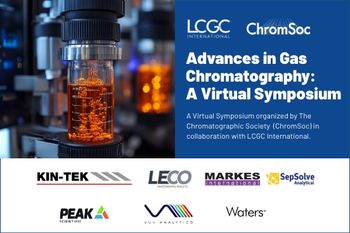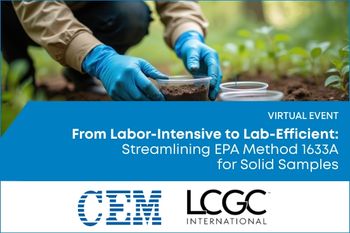
- August 2021
- Volume 39
- Issue 8
The Analytical Arsenal for Point Source Attribution
How can we monitor the source and environmental impact of neglected oil and gas acquisition sites, and assess their impact over time?
The past year has been a remarkable ride for the oil and gas industry, and for the entire energy sector in general. Extreme volatility in commodity pricing, an oil contango, and an apparent paradigm shift away from fossil fuel-powered vehicles has all been “par for the course” in the past 12 months. Fortunately, the petroleum industry appears to be making significant strides to improve the environmental stewardship and operational efficiency of energy production by implementing new technologies and capitalizing on previously wasted resources like produced water and flare gas. Nonetheless, many questions still remain about the management of aging or abandoned infrastructure, specifically, “How can we monitor the environmental impacts of these neglected sites, and will these impacted sites grow in magnitude over time?” To answer this question, we must first understand what is required to perform such analyses.
In many cases, a relatively straightforward analysis of the environment can provide sufficient insight into the extent of environmental damage from a specific source (1). In the case of alleged groundwater contamination, using ion chromatography and inductively coupled plasma–mass spectrometry (ICP-MS), we can characterize various brine elements (chloride and bromide) and pertinent metal ions species, respectively, to better under the extent of fluid migration from flowback and produced water. Concurrently, gas and liquid chromatography–mass spectrometry (GC–MS and LC–MS) can be utilized to characterize the presence of volatile and semi-volatile organic compounds, which collectively can be representative of chemical additives used in the energy production process (that is, hydraulic fracturing) and be a reflection of other natural gas constituents (C1-C5 hydrocarbon gases) being present.
In the event that natural gas is present, as may be evidenced by a strong sulfur-bearing aroma or water effervescence, the characterization of methane, ethane, and propane, and their respective carbon isotopes, can provide insight into the origin of the rogue gas and help differentiate between naturally occurring biogenic (microbial) gas and thermogenic gas that may have made its way into the water via anthropogenic activities.
In numerous cases, we have seen that the isotopic signature of the rogue natural gas in a water source is a match with the equivalent signature collected from a nearby production well. Case closed, right? Not exactly. In some instances, there may also be a naturally occurring source of shallow gas that is not economically viable to extract, and that has a comparable isotopic signature to the two other thermogenic gases. In situations like these, higher-resolution analytical tools are required to parse out the differences. For example, the relatively recent emergence of noble gas and noble gas isotopic analyses has allowed investigators the opportunity to better perform point source attribution, and simultaneously characterize the migration pathway from the contamination source to the contamination site (2,3). Because noble gases are chemically inert and are not subject to oxidation and microbial degradation, they are ideal tracer elements that can be used to better understand subsurface fluid and gas migration. Using the aforementioned case with three matching methane isotope signatures, the characterization of noble gas analytes allowed us to differentiate water wells that had been inadvertently drilled directly into the intermediate gas layer from those that has been impacted by the activities of a nearby production well (4).
Unconventional oil and gas extraction is a multi-faceted landscape. From assessment of air, soil, and water quality to oilfield wastewater treatment and reuse, there are many places where both routine and advanced chemical analysis can provide insight. We will continue to be faced with situations where environmental forensics and point source attribution are needed to understand the cause of various contamination events. Even if fossil fuel extraction declines significantly over the next 20 years, we will still be left with the need to ensure abandoned well sites are properly closed and pose no threat to the environment. We have the technology and the know-how, but of course, there are still real limits in the research that can be performed with limited to no investment in such studies from traditional funding agencies.
References
(1) I.C. Santos, Z.L. Hildenbrand, K.A. Schug, Anal. Chem. 91, 689–703 (2019).
(2) T.H. Darrah, A. Vengosh, R.B. Jackson, N.R. Warner, and R.J. Poreda, Proceedings of the National Academy of Sciences 111(39), 14076–14081 (2014).
(3) C.J. Whyte, A. Vengosh, N.R. Warner, R.B. Jackson, K. Muehlenbachs, F.W. Schwartz, and T.H. Darrah, Sci. Total Environ. 780, 146555 (2021).
(4) Z.L. Hildenbrand, D.D. Carlton Jr., A.P. Wicker, et al., Sci. Tot. Environ. 713, 136618 (2020).
Zacariah L. Hildenbrand is a Research Professor at the University of Texas at El Paso, Texas. Kevin A. Schug is a Full Professor and the Shimadzu Distinguished Professor of Analytical Chemistry in the Department of Chemistry & Biochemistry at The University of Texas at Arlington. Direct correspondence to:
Articles in this issue
Newsletter
Join the global community of analytical scientists who trust LCGC for insights on the latest techniques, trends, and expert solutions in chromatography.





